According to a recent study by Global Market Insights, the air source heat pump market value is projected to cross $77 billion by 2028. Increasing demand from growing real estate sector along with soaring requirement of space heating applications across colder regions will encourage the product deployment. Air to water source heat pumps segment is Read more
Featured Articles
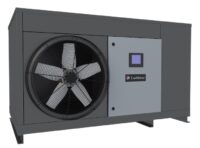
According to a recent study by Global Market Insights, the air source heat pump market value is projected to cross $77 billion by 2028. Increasing demand from growing real estate sector along with soaring requirement of space heating applications across colder regions will encourage the product deployment.
Air to water source heat pumps segment is anticipated to witness a noteworthy growth owing to various features including simple design and easy installation, says the report. Rising global temperature and growing green building construction will provide positive drivers for product deployment. Integration with solar heating source and hence low input cost for product across temperate countries will drive the space heating systems demand in the forecast timeline.
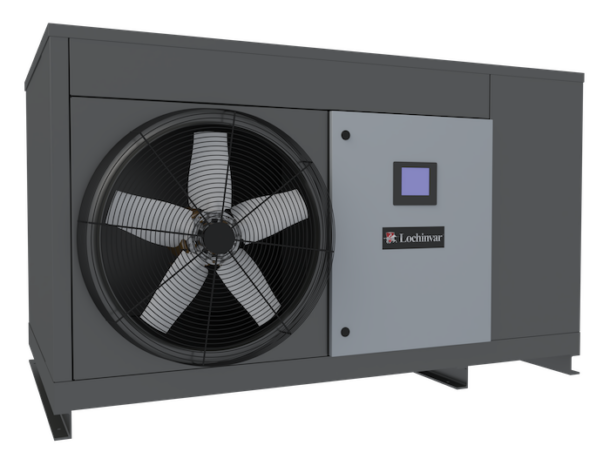
Lochinvar’s air source heat pump water heater
The movement towards electrification—moving away from fossil fuel—seems to be the main driver of the heat pump movement. “I think consumers see an option to add PV, or join a solar garden, to become more energy independent. So having a heating, cooling and DHW option powered by your roof makes some sense. The rise in fossil fuel prices, uncertainty around supply certainly adds some motivation to look at heat pumps,” says Bob ‘Hot Rod’ Rohr, training manager, Caleffi, and former hydronic contractor of more than 30 years.
Recently, Mechanical Hub spoke with Arthur Smith, Residential Product Manager, A. O. Smith, and Jennifer Russell, Segment Development Manager, Decarbonization, Lochinvar, to get the latest on heat pump technology and heat pumps water heaters.
MH: What are some of the driving forces behind this technology?
Arthur: At A. O. Smith, we’ve seen two major driving factors behind the increasing popularity of residential heat pump water heaters. First, as consumers have begun to see wider availability of this technology, along with its carbon emissions reduction and tremendous cost savings, they’ve pushed to utilize heat pump water heaters in their own homes, further increasing demand. The second driving factor we’ve seen is the evolving regulations around decarbonization. These changes have placed an emphasis on heat pump technology as an excellent option for greenhouse gas reduction.
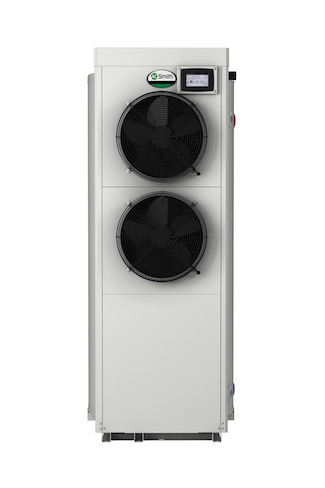
A. O. Smith’s CHP-120 heat pump water heater
Jennifer: On the commercial side, greenhouse gas emission reduction is the main driving force behind the increase and development of heat pump technology. However, due to the lack of availability of commercial heat pump technology, we don’t see it utilized in applications as often as the residential sector. In addition to state and local reduction goals, there are also many companies and building owners who are setting their own goals for reducing greenhouse gas emissions and they’re seeking out heat pump water heaters as a way to meet those goals.
MH: What are the benefits of heat pump technology?
Arthur: The core benefit of heat pump water heaters is the massive jump in efficiency. High efficiencies drive cost savings, which is a huge benefit to homeowners.
Jennifer: One of the main benefits of heat pump technology is that there are zero direct carbon emissions from the unit. For any commercial building looking to decrease its environmental impact footprint, this technology can play a big role in meeting those goals. In addition to the environmental benefits, heat pump technology is also incredibly efficient, providing an average annual efficiency of 200-300%.
MH: Do you see demand for heat pumps more on the residential side than commercial? What is the ratio?
Arthur: Overall, we’ve seen significant interest in both commercial and residential applications.
Jennifer: At Lochinvar, we’ve seen interest in both commercial and residential applications. Interest in ommercial applications for heat pump water heaters has grown significantly in the last couple of years, primarily due to evolving state and local environmental regulations.
Can the grid support a heat pump transition?
Arthur: The grid has been able to support the transition so far, but as heat pump technology continues to increase in popularity, developing the grid will need to be prioritized. It seems that most regulators are aware of this need to develop the grid and are building their regulations accordingly so the grid isn’t overwhelmed.
Jennifer: While the grid may be able to support a heat pump transition eventually, it can’t happen overnight. It’s going to take many years to fully develop a grid that can support a full transition to heat pump technology. In the meantime, we can develop and implement tools, such as demand-response technology, to help support the transition.
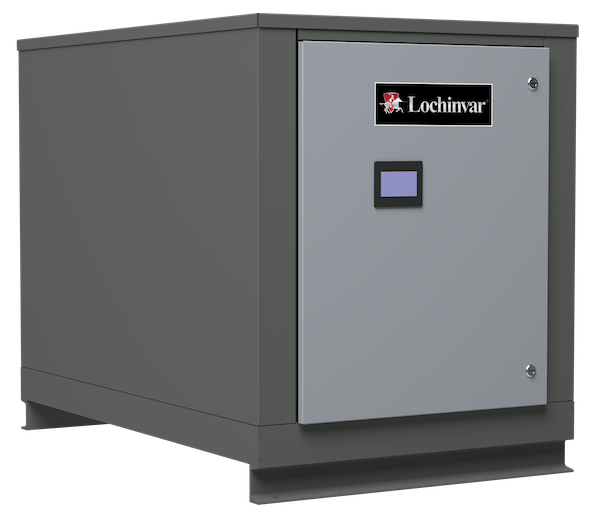
Commercial Heat Pump Water Heater
MH: Is a different skill set required for installation?
Arthur: On the residential side, there isn’t a different skill set required for installation. A. O. Smith designed our residential heat pumps so they can be installed in almost the same way as our standard electric water heaters. There are still some minor considerations, like draining non-acidic condensate produced by heat pumps and differing space requirements, but overall, the installation process is nearly the same as what most contractors are familiar with now.
Jennifer: There isn’t a different skill set required for installation, but there is unique training that can better prepare someone to install or service heat pumps. Heat pump water heaters have features that differ from traditional water heaters and these features require different training. Lochinvar offers training to help educate on the unique application features of heat pump technology.
MH: What is the life expectancy compared to boilers?
Arthur: Our heat pump water heaters are built to the same quality standards as all A. O. Smith products. We put care into developing products that perform well throughout their lifetime. We’re confident in our products and offer a standard 10-year limited warranty on every heat pump we produce.
Jennifer: You’re not going to see any loss of life expectancy with heat pump water heaters. They’re designed to hold up and perform as well as other water heating technology
MH: Do you offer training for these products?
Arthur: Since residential heat pump technology has been around for a bit longer than commercial, we’ve had time to develop training resources that focus on the installation and servicing of these units. A. O. Smith University offers digital live training at www.university.hotwater.com and there are courses available that focus specifically on heat pump technology.
Jennifer: At Lochinvar, we offer training resources to educate sales reps, engineers, contractors and technicians on heat pump technology. At the moment, our heat pump training focuses on topics such as applications for heat pumps, ensuring the correct unit size specification and understanding the technology’s benefits and features.

San Antonio — The seventh Emerging Water Technology Symposium returned as an in-person event for the first time in four years, bringing together industry, manufacturing, water utility and government leaders from around the world. A focus of this year’s event was on resources communities require to build safe and resilient plumbing systems as well as Read more
San Antonio — The seventh Emerging Water Technology Symposium returned as an in-person event for the first time in four years, bringing together industry, manufacturing, water utility and government leaders from around the world. A focus of this year’s event was on resources communities require to build safe and resilient plumbing systems as well as meet the growing list of challenges to America’s drinking water.
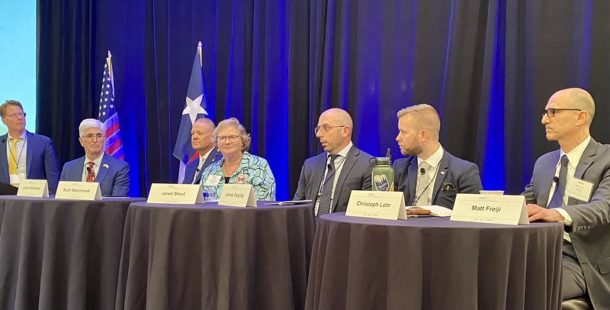
The esteemed panel on Effective Risk Management of Building Water Systems for Pathogen Control included (from l to r) Julius Ballanco, president, JB Engineering; Kurt Steenhoek, International Representative, UA; Janet Stout, Executive VP and Founder, Special Pathogen Laboratory; James Dipping, Director of Plumbing Engineering, Environmental Systems Design, Inc.; Christoph Lohr, VP of Strategic Initiatives, IAPMO; and Matt Freije, CEO, HC Info.
The May 10-11 event at the Westin Riverwalk, San Antonio was co-convened by the Alliance for Water Efficiency (AWE), the American Society of Plumbing Engineers (ASPE), the International Association of Plumbing and Mechanical Officials (IAPMO) and Plumbing Manufacturers International (PMI).
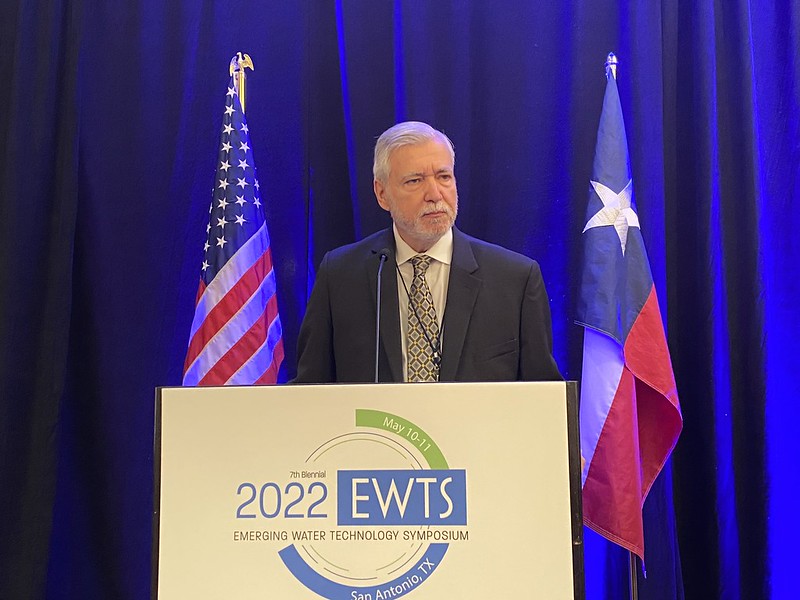
Pete DeMarco
“As an industry we have a number of high priority research needs that relate to water quality as well as water and energy efficiency,” IAPMO Executive Vice President of Advocacy and Research Pete DeMarco explained in discussing the importance of the symposium. “This year’s event brought together some of the brightest minds industry has to offer all focused on how we make our plumbing and mechanical systems safer and more resilient to meet the challenges ahead.”
In his opening remarks, DeMarco pointed to a number of accomplishments for which the EWTS has served as a springboard, including the development of the Green Plumbing and Mechanical Code Supplement (now the Water Efficiency and Sanitation Standard WE•Stand); ANSI/ASHRAE Standard 188-2018, Legionellosis: Risk Management for Building Water Systems; ASSE 12000 series on infection control and water quality, which is in IAPMO’s Uniform Plumbing Code (UPC®); and IAPMO’s Water Demand Calculator, whose second version was released in 2020.
“This symposium provides a much-needed platform for stakeholders across the industry to gather, discuss the latest research, and then discuss how we can take action,” he said. “It is a highly valuable event, and I look forward to seeing it continue to grow in the future.”
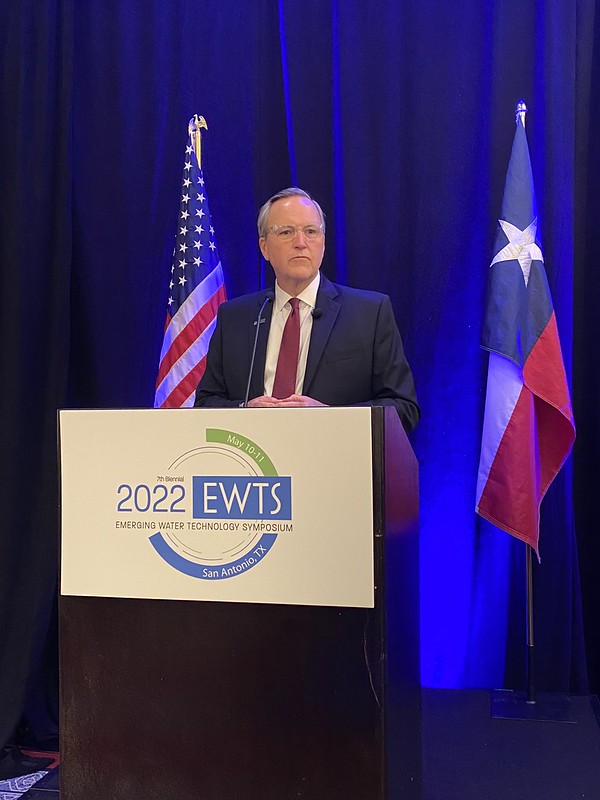
Kerry Stackpole
PMI CEO Kerry Stackpole spoke at the event and said the relationships between the organizations represented at EWTS had likely never been more important than they are now. He said that while the best and brightest among us devised medical solutions to the COVID-19 pandemic, the plumbing industry also played an important role.
“What’s also important is how our industry responded,” he said. “Our industry’s experience and our focus became touchless faucets, antimicrobial surfaces, water purification systems, all kinds of energy-efficient devices focused on safe and responsible plumbing. We all had a contribution to make and I think our industry stepped up.”
Stackpole said wildfires, flooding and drought that different regions of the United States are experiencing put those in the industry in a position to shape the future.
“Your active engagement here, in your communities back home, and in the marketplace of ideas, where we will have opportunities to share ideas with one another, will make all the difference,” he said. “You actually are able to turn the dial on this, and I think that’s really exciting.”
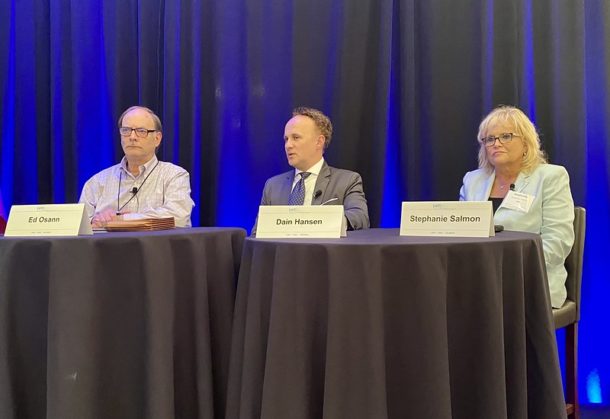
A day 2 panel saw (from l to r) Ed Osann, Senior Water Policy Analyst, NRDC; Dain Hansen, Executive Vice President, Government Relations, IAPMO; and Stephanie Salmon, Washington Representative, PMI, talk about the implications of the Infrastructure Investment and Jobs Act on Drinking Water and Wastewater.
This year’s keynote speakers were Robert Puente, president and CEO of the San Antonio Water System (SAWS), and Don Johnston, senior operations director, Indonesia, for Water.org.
Puente’s presentation looked at three ways in which SAWS, which serves 2 million customers over four counties, uses innovation to deliver water to its customers: advanced metering deployment, “smart” manhole covers, and conservation.
“It’s all about innovation,” he said. “And I think if you talk to our employees, although they will tell you that it’s their idea, we know that they got their idea from coming to events like this. Every good idea, you should expect it to be stolen, to be used by someone else, and you should be flattered by that. I think anything that you look at here started somewhere else, and we went to conferences in other cities and were able to bring back the ideas to SAWS to really get the innovation aspect in this.”
In delivering his keynote address remotely from Jakarta, Indonesia, Johnston spoke about the global water and sanitation crisis’s impact on low-income households — one in nine people lack access to safe water, one in three do not have access to a toilet — and some potential solutions. Working with financial institutions and water utilities, as well as sister company WaterEquity, Water.org helps bring affordable financing to people in need of water.
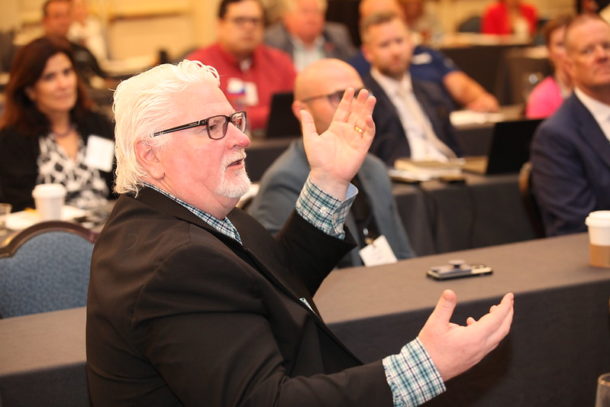
The Hub’s John Mesenbrink asks the hard-hitting questions during the symposium.
“In about 19 years of work on the ground, we’ve seen water and sanitation access reach more than 45 million people through more 10 million microloans disbursed to households with capital of $3.7 billion mobilized,” he said.
In his presentation, Phillip White, manager of plumbing and mechanical inspections for the city of Vancouver, British Columbia, shared how his city addressed the problem of insufficient sewer capacity when it came to capturing large amounts of rainfall through water reuse technologies. One development, the Oakridge Centre, utilized the IAPMO Water Demand Calculator and is expected to have the largest non-potable water system in North America.
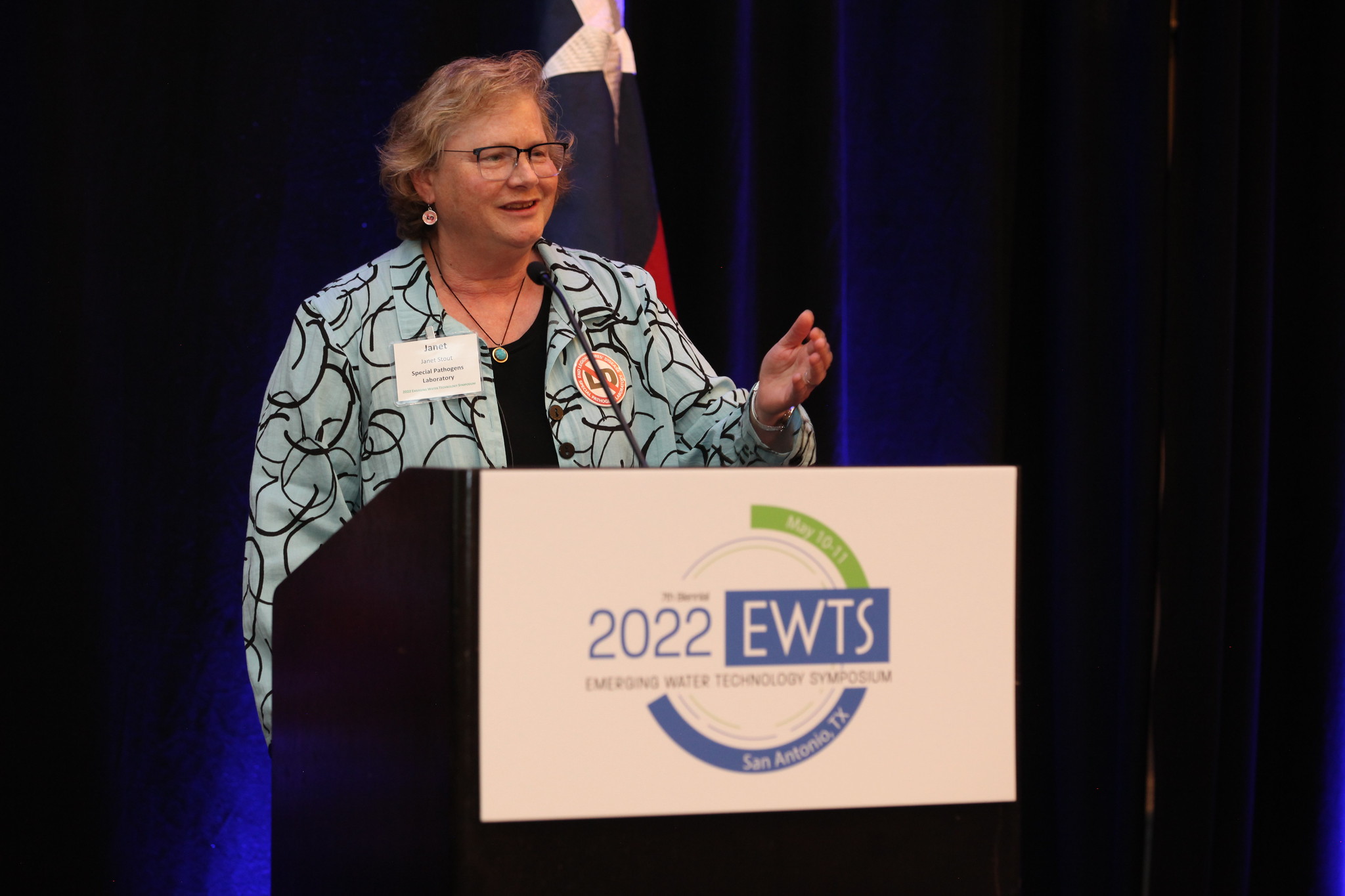
Janet Stout
Another speaker, Special Pathogens Laboratory Executive Vice President/Founder Dr. Janet Stout, looked at approaches and products for mitigating the risk of Legionellosis in point-of-use and point-of-entry building water systems. Improved water management requires knowledgeable Legionella prevention and water service providers, which can come from certification to ASSE/IAPMO/ANSI 12080 for Legionella Water Safety and Management Personnel.
IAPMO will provide sessions from the EWTS on-demand in the near future. To be notified when they are available, register at www.ewts.org/2022-ewts.
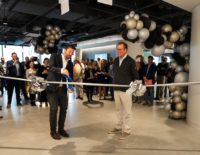
Flagship showroom in Fulton Market District highlights Sloan’s full suite of aesthetic, hygienic commercial restroom products. Chicago—On a dreary Tuesday morning in early May, Sloan sparkled by holding a ribbon-cutting ceremony to celebrate the opening of its flagship showroom and office space in the Fulton Market District. The flagship showroom highlights Sloan’s full suite of aesthetic Read more

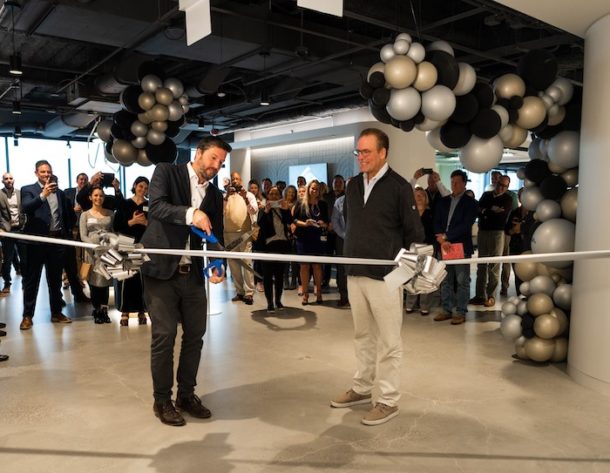
Taking part in the ribbon cutting ceremony for the new space were Graham Allen and Kirk Allen, Sloan co-presidents and CEOs and fourth generation descendants of company founder William Elvis Sloan.

The Hub’s John Mesenbrink took part in some AR technology from the showroom.
Located on the building’s 10th floor, Sloan’s showroom space represents a return to the company’s origins, as Sloan was initially founded on nearby Jackson Boulevard prior to moving to its current Franklin Park headquarters in 1975. The new building features an office space and showroom, while Sloan’s manufacturing and corporate headquarters remains in Franklin Park.
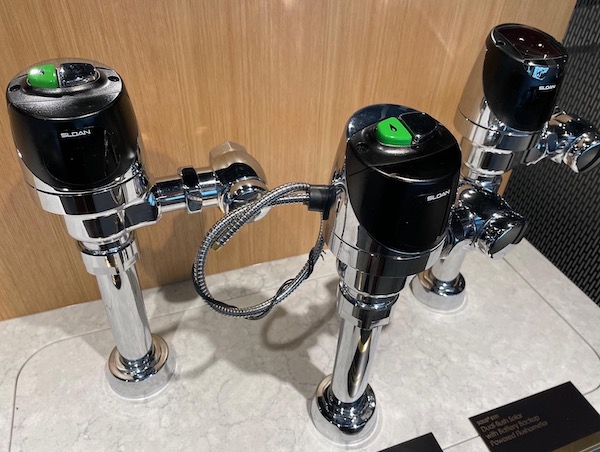
The showroom features a wide range of Sloan products and innovations, including flushometers.
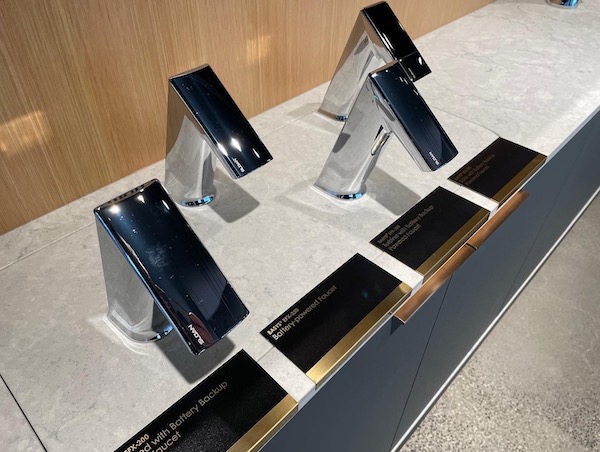
The showroom features a wide range of Sloan products and innovations, including sensor-activated faucets.
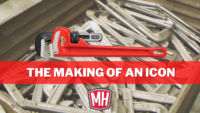
https://youtu.be/VD8thVlIZP8 Our latest Hub On The Road series video brings us to RIDGE Tool company to see the making of their iconic pipe wrench. The world famous cast iron pipe wrench is started at the Urick Foundry in Erie, PA. We get the very first public look into this decades old manufacturing facility were the Read more
Our latest Hub On The Road series video brings us to RIDGE Tool company to see the making of their iconic pipe wrench.
The world famous cast iron pipe wrench is started at the Urick Foundry in Erie, PA. We get the very first public look into this decades old manufacturing facility were the molten metals are poured into molds, sand is cast and robots work alongside dedicated employees with years of service.
From Urick the guys take their fresh wrench to Elyria, OH to RIDGID’s world headquarters and factory floor to finish the process of grinding, painting, assembling the plumbing and piping industries most iconic tool.
This video is a first ever look behind the scenes of this American made legend. We at MH thank whole hearteldy our partners and friends for welcoming us into their house and allowing us to make this video.
We sincerely hope you find this entertaining,
Team MH
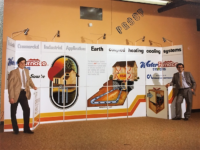
This is the first in a multi-part series on the history of geothermal heating and cooling in the United States and beyond. It focuses on the efforts of two men: Dan Ellis and David Hatherton, the latter having trademarked the WaterFurnace name back in 1981 in Ontario, Canada. David Hatherton is the son of a Read more
This is the first in a multi-part series on the history of geothermal heating and cooling in the United States and beyond. It focuses on the efforts of two men: Dan Ellis and David Hatherton, the latter having trademarked the WaterFurnace name back in 1981 in Ontario, Canada.
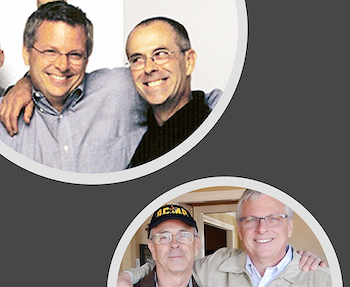
David Hatherton and Dan Ellis
David Hatherton is the son of a water well driller with business operations located in Ontario, Canada. David first noted the energy available in the ground during one particularly cold winter day in Ontario. He still remembers inadvertently placing his hand into the water flowing from a newly drilled water well. He recalls how startled he was that it felt so warm. That’s when he realized that there was truly thermal energy available in the ground. He realized that this is an unlimited resource; if only he could just figure out how to tap it and turn it into heating for home buildings.
In 1980, David’s father passed away, and David did not want to continue in the drilling business. Instead, he put together a water source heat pump that he tied into one of the water wells on his property. Shortly after that, he came up with the name “WaterFurnace,” and trademarked it in Ontario, Canada.
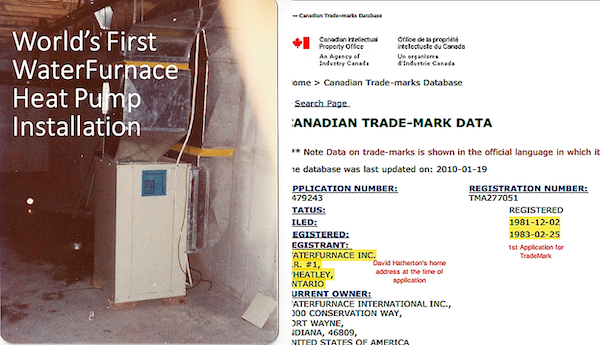
The First WaterFurnace Installation & Trademark Paperwork
Interestingly, many folks did not like the name WaterFurnace. But as Dave shared, the name told the story of the water source heat pump. Instead of a furnace that combusted some type of fuel, the WaterFurnace heat pump used the energy from water in the earth to provide heat.
Meanwhile, Dan Ellis was in the business of saving oil and energy. Starting in 1978, a year of double-digit inflation, Dan was working out of an old van and had started a company called “Genesis Energy Systems.” His idea involved a water source heat pump with a solar thermal boost. You can see the first article that ran in 1982 about that system in the Air Conditioning, Heating & Refrigeration News.
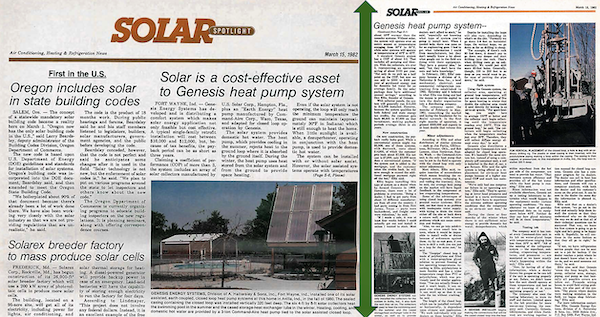
The News Article from March 15, 1982
This article piqued David’s interest, and he traveled to Fort Wayne, Ind., to meet Dan Ellis at the office of a successful HVAC contractor, Command Air, at which Dan was a division manager. They had dinner with Harmon Hensley https://www.ahattersley.com/our-story , President of Hattersley and Sons in Fort Wayne, a man of means that caught this vision of what they wanted to do.
About the same time, the late Dr Jim Bose of Oklahoma State University (OSU) started working with Gerald Parker on geothermal closed loop science, coming up with the first equations for piped heat transfer in a horizontal closed loop exchanger. That effort eventually spawned the International Ground Source Heat Pump Association (IGSHPA) in 1987 https://igshpa.org/about-us/.
When you consider the date on Dave’s certificate for successful completion of the Closed-Loop Earth-Coupled Heat Pump Workshop, which was signed by Dr Jim Bose, it gives an idea of how far ahead they were. The date of Dave’s attendance is February 24, 1983, and IGSHPA was organized at Oklahoma State University 4 years later in 1987, with Dr. Jim Bose as the Executive Director.
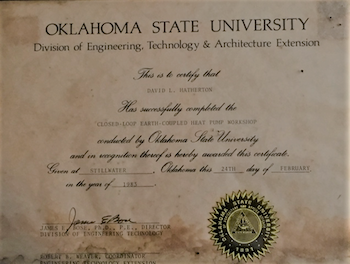
David’s 1983 OSU Closed-Loop Certificate
The pair was set to be a prime distributor for Command Air, on which they planned to affix the new ‘WaterFurnace” label, but the deal did not materialize. They went on to work with investors to create WaterFurnace International in April 1983 in what they affectionately call the “carpeted warehouse.” You can see the harvest-gold carpet in the image in which they are standing proudly in front of the first WaterFurnace booth.
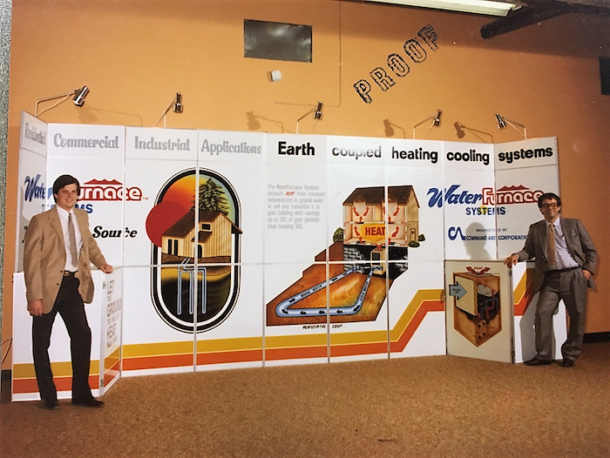
The First WaterFurnace Trade Show Booth
Dan wrote a letter to get Dave a visa to come to U.S. to work as the Executive VP of WaterFurnace. By January of 1984, according to the letter, Dave’s distribution company in Ontario had sold $500,000 worth of WaterFurnace equipment and was the largest single distributor in North America. As a result of their alliance, during 1984, WaterFurnace set up about 20 distributors, enlisted the support of electrical coops to monetize geothermal heat pump rebates in their areas, and had completed some significant commercial projects involving as many as 324 vertical boreholes.
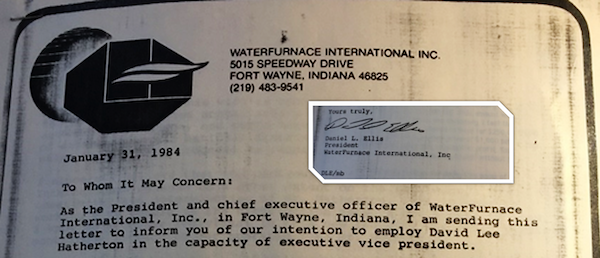
Employment Letter from Dan to David
At this time, the Carter Administration still had federal tax credits on the rolls for heat pumps, but those were eliminated by the new administration in 1984. Even with that, WaterFurnace sold $2.2 million in geothermal heat pumps by the end of 1984, showing a $300,000 profit.
When the Command Air part of the deal failed, Dan Ellis arranged for the purchase the water-source division of McQuay with the help of investors, which bootstrapped WaterFurnace fully into the manufacturing business in 1985.
In the next segment, we’ll share information on Dave moving back to Ontario where he worked with the utility to get 7,300 systems installed in three years, Dan moved over to ClimateMaster, and guided them from the red to a $200M company in 10 years.
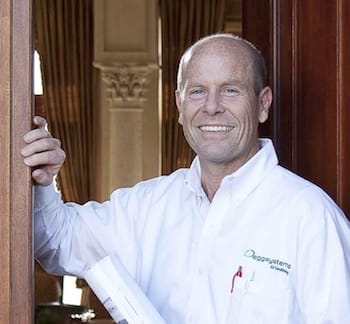 Jay Egg is a geothermal consultant, writer, and the President of Egg Geo, LLC. He has co-authored two textbooks on geothermal HVAC systems published by McGraw-Hill Professional. He can be reached at jegg@egggeo.com
Jay Egg is a geothermal consultant, writer, and the President of Egg Geo, LLC. He has co-authored two textbooks on geothermal HVAC systems published by McGraw-Hill Professional. He can be reached at jegg@egggeo.com
